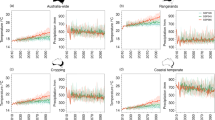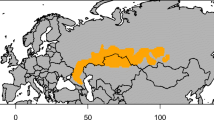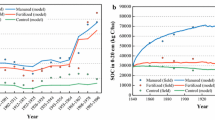Abstract
Under the threat of global warming it is important to determine the impact that future changes in climate may have on the environment and to what extent any adverse effects can be mitigated. In this study we assessed the impact that climate change scenarios may have on soil carbon stocks in Canada and examined the potential for agricultural management practices to improve or maintain soil quality. Historical weather data from 1951 to 2001 indicated that semi-arid soils in western Canada have become warmer and dryer and air temperatures have increased during the spring and winter months. Results from the Canadian Center for Climate Modelling and Analysis (CCCma) Coupled Global Climate Model (CGCM1,2) under two climate change forcing scenarios also indicated that future temperatures would increase more in the spring and winter. Precipitation increased significantly under the IPCC IS92a scenario and agreed with historical trends in eastern Canada whereas the IPCC SRES B2 scenario indicated very little change in precipitation and better matched historical trends in western Canada. The Century model was used to examine the influence of climate change on agricultural soil carbon (C) stocks in Canada. Relative to simulations using historical weather data, model results under the SRES B2 climate scenario indicated that agricultural soils would lose 160 Tg of carbon by 2099 and under the IS92a scenario would lose 53 Tg C. Carbon was still lost from soils in humid climatic regions even though C inputs from crops increased by 10–13%. Carbon factors associated with changes in management practices were also estimated under both climate change scenarios. There was little difference in factors associated with conversion from conventional to no-till agriculture, while carbon factors associated with the conversion of annual crops to perennial grass were lower than for historical data in semi-arid soils because water stress hampered crop production but were higher in humid soils.
Similar content being viewed by others
References
Bellamy PH, Loveland PJ, Bradley RI et al (2005) Carbon losses from all soils across England and Wales. Nature 437(7056):245–248
Campbell CA, Zentner RP, Selles F et al (2000) Quantifying short-term effects of crop rotations on soil organic carbon in southwestern Saskatchewan. Can J Soil Sci 80:193–202
Cutforth HW, McConkey BG, Woodvine RJ et al (1999) Climate change in the semiarid prairie of southwestern Saskatchewan: late winter-early spring. Can J Plant Sci 79:343–350
Davidson EA, Janssens IA (2006) Temperature sensitivity pf soil carbon decomposition and feedbacks to climate change. Nature 440:165–173
Flato GM, Boer GJ (2001) Warming asymmetry in climate change simulations. Geophys Res Lett 28:195–198
Flato GM, Boer GJ, Lee WG et al (2000) The Canadian centre for climate modelling and analysis global coupled model and its climate. Clim Dyn 16:451–467
Grant B, Smith WN, Desjardins RL et al (2004) Estimated N2O and CO2 emissions as influenced by agricultural practices in Canada. Clim Change 65:315–332
Hamilton JG, Delucia EH, George K (2002) Forest carbon balance under elevated CO2. Oecologia 131:250–260
IPCC (2001) In: Houghton JT, Ding Y, Griggs DJ, Noguer MVD, Linden PJ, Dai X, Maskell K, Johnson CA (eds) Climate change 2001: the scientific basis. Contribution of working group I to the third assessment report of the intergovernmental panel on climate change. Cambridge University Press, Cambridge, UK, p 881
Jenkinson DS, Adams DE, Wild A (1991) Model estimates of CO2 emissions from soil in response to global warming. Nature 351:304–306
Jones C, McConnell C, Coleman K et al (2005) Global climate change and soil carbon stocks: predictions from two contrasting models for the turnover of organic carbon in soil. Glob Chang Biol 11:154–166
King AW, Gunderson CA, Post WM et al (2006) Plant respiration in a warmer world. Science 312(5773):536–537
Leggett J, Pepper WJ, Swart RJ (1992) Emissions scenarios for the IPCC: an update. In: Houghton JT, Callander BA, Varney SK (eds) Climate change 1992: the supplementary report to the IPCC scientific assessment. Cambridge University Press, Cambridge, pp 69–95
McGinn SM, Toure A, Akinremi OO, Major DJ, Barr AG (1999) Agroclimate and crop response to climate change in Alberta, Canada. Outlook Agric 28:19–28
Nakicenovic N, Alcamo J, Davis G et al (2000) IPCC special report on emissions scenarios. Cambridge University Press, Cambridge, UK, p 599
Ojima DS, Parton WJ, Schimel DS (1993) Modelling the effects of climatic and CO2 changes on grassland storage of soil-C. Water Air Soil Pollut 70:643–657
Parton WJ, Persson J, Anderson DW (1982) Simulation of organic matter changes in Swedish soils cultivation. In: Analysis of ecological systems: state-of-the-art in ecological modelling: proceedings, 24–28 May 1982, Colorado State University. Elsevier Scientific Publ Co., Fort Collins, CO, pp 5111–5116
Parton WJ, Schimel DS, Cole CU, Ojima DS (1987) Analysis of factors controlling soil organic matter levels in great plains grasslands. Soil Sci Soc Am J 51:1173–1179
Parton WJ, Scurlock JMO, Ojima DS et al (1993) Observations and modelling of biomass and soil organic matter dynamics for the grassland biome worldwide. Glob Biogeochem Cycles 7:785–809
Robinson DA, Heim RR Jr (2006) Trends and variability of snowfall and snow cover across North America and Eurasia. Part 2. What the data say. In: 18th conference on climate variability and change. The 86th Annual AMS Meeting, Jan 30th to Feb 2nd, Atlanta, GA
Smith WN, Desjardins RL, Grant B (2001) Estimated changes in soil carbon associated with agricultural practices in Canada. Can J Soil Sci 81:221–227
Soil Classification Working Group (1998) The Canadian system of soil classification. Agriculture and Agri-Food Canada Publ. 1646 (Revised), Canada, p 187
Trumbore SE, Chadwick OA, Amundson R (1996) Rapid exchange between soil carbon and atmospheric carbon dioxide driven by temperature change. Science 272:393–396
Vandenbygaart AJ, Yang XM, Kay BD et al (2002) Variability in carbon sequestration potential in no-till soil landscapes of sourthern Ontario. Soil Tillage Res 65:231–241
Vandenbygaart B, Angers D, McConkey B et al (2008) Soil carbon change factors for the Canadian agriculture national greenhouse gas inventory. Can J Soil Sci (in press)
Vincent LA, Wijngaarden WA, Hopkinson R (2007) Surface temperature and humidity trends in Canada for 1953–2005. J Climate 20:5100–5113
Wythers KR, Reich PB, Tjoelker MG, Bolstad PB (2005) Foliar respiration acclimation to temperature variable Q10 alter ecosystem carbon balance. Glob Chang Biol 11:435–439
Author information
Authors and Affiliations
Corresponding author
Rights and permissions
About this article
Cite this article
Smith, W.N., Grant, B.B., Desjardins, R.L. et al. Potential impact of climate change on carbon in agricultural soils in Canada 2000–2099. Climatic Change 93, 319–333 (2009). https://doi.org/10.1007/s10584-008-9493-y
Received:
Accepted:
Published:
Issue Date:
DOI: https://doi.org/10.1007/s10584-008-9493-y




